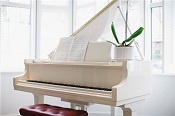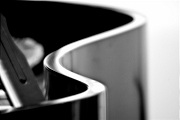
Home > Beginner Piano Lessons > Parts Of A Piano
|
||||
Parts Of A Piano - An Overview
Any instrument is made up of a complex set of parts. Even more so with the piano, it being a large, complex instrument. Many parts have to work together at the same time to produce sounds pleasing to the ear. Although an upright piano, a baby grand and a grand piano vary slightly in looks, they are made up of the same parts: Lid/cover: Depending on the type of piano, a piano can have a lid or a cover. A baby grand and a grand piano have a lid which opens and is held open by a lid prop. An upright piano has a top cover only which stays closed while the piano is being played. This is connected to an upper panel and goes down into the bottom panel. Music rack: The music rack is the shelf which holds the music sheets. Fall: The fall is the cover which closes over the keyboard. The keyboard: A standard piano has 88 keys on its keyboard. There are 36 black keys which are sometimes referred to as “sharps” and 52 white keys.
On grand pianos, it is common to find a third pedal, the ‘sostenuto’ pedal. Often this pedal is forgotten. Its functions is to sustain only the notes being played at the time while the damper pedal is being played. Pianos also have inner parts which are the inner mechanisms which enable the instrument to emit sounds. Felt-covered hammer: To enable the piano to be played and to emit a sound, a piano has a felt-covered hammer of sorts connected to the keyboard and when any key on the keyboard is pressed this causes the felt-covered hammer to hit a steel string on the piano and bounce back. The strings: Inside a piano there are strings. These strings are not visible to the observer from the outside of the piano. These steel strings, with the help of other mechanisms, emit the sound from a piano. When a pianist presses down on a key, a felt-covered hammer hits the steel strings. The strings then reverberate and the continuing sound of the music note associated with that key is heard. Occasionally, it is important for routine maintenance for a professional to tune your piano for the best tones. This is not an exhaustive list of the parts of a piano however these are the basics which are found with any make or kind of piano. The piano has many intricacies and small elements which make it into the instrument which it is. Because there is more than one kind of piano (upright, baby grand and grand) as well as different manufacturers of pianos, each one can differ slightly in its internal make up. Therefore there are many small inner parts which work together with the main parts described above to emit a sound and to give the piano the recognisable look it has.
http://pianoplayerworld.com/300PagePianoWorkbook.html
| ||||
|
Although every attempt has been made to make information as accurate as possible, we are not responsible for any errors that may appear.
 Before we dive deeper into any
Before we dive deeper into any 
 The pedals: The pedals are located at the bottom of the piano and assist in
varying the sound emitted by a piano. A standard piano has two pedals: the ‘una corda’ which is the soft pedal
and dulls the sound of a melody being played and the ‘damper’ pedal which sustains the sound.
The pedals: The pedals are located at the bottom of the piano and assist in
varying the sound emitted by a piano. A standard piano has two pedals: the ‘una corda’ which is the soft pedal
and dulls the sound of a melody being played and the ‘damper’ pedal which sustains the sound.



